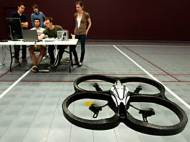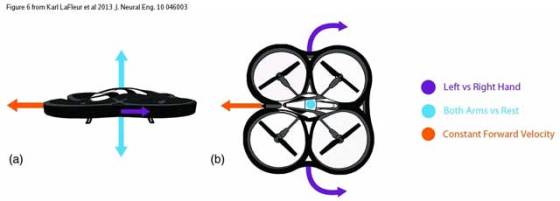Using thoughts to control a quadcopter in 3D space
 Researchers at the University of Minnesota managed to devise a way to use thoughts in order to control the movement of a four-blade helicopter, also known as a quadcopter. The research is conducted in hope the results could be used in systems of future robots that can help restore the autonomy of paralyzed victims or those suffering from neurodegenerative disorders.
Researchers at the University of Minnesota managed to devise a way to use thoughts in order to control the movement of a four-blade helicopter, also known as a quadcopter. The research is conducted in hope the results could be used in systems of future robots that can help restore the autonomy of paralyzed victims or those suffering from neurodegenerative disorders.
By using brain-computer interface (BCI), the researchers managed to make the quadcopter turn, rise, dip, and even fly through a ring. The noninvasive technique used was electroencephalography (EEG), which recorded the electrical activity of the subject’s brain through a cap fitted with 64 electrodes. Quadcopter used in the experiment was previously described in our article about AR Drone.
BCI works thanks to the geography of the motor cortex (the area of the cerebrum that governs movement). When we move, or think about a movement, neurons in the motor cortex produce small amounts of electric current. Thinking about a different movement activates a new set of neurons.
There were five subjects (three female, two male) that were facing away from the quadcopter with the task to think about use of their right hand, left hand, and both hands together – a set of thoughts that would instruct the quadcopter to turn right, left, lift, and then fall, respectively. The velocity and direction of the quadcopter during the experiments was pre-set in order to simplify the control.
The subjects were positioned in front of a screen which relayed images of the quadcopter’s flight through an on-board camera, allowing them to see in which direction it was traveling. Brain signals were recorded by the cap and sent to the quadcopter over WiFi.
After several different training sessions, the subjects were required to fly the quadcopter through two foam rings suspended from the gymnasium ceiling and were scored by the number of times they sent the quadcopter through the rings, by the number of times the quadcopter collided with the rings, and by the number of times they went outside the experiment boundary.
The subjects took part in the study and each one was able to successfully control the, quickly and accurately for a sustained amount of time. A number of statistical tests were used to calculate how each subject performed. A group of subjects also directed the quadcopter with a keyboard in a control experiment, allowing for a comparison between two methods.
This process is just one example of a BCI where a direct pathway between the brain and an external device is created to assist, augment or repair human cognitive or sensory-motor functions. University of Minnesota researchers are currently looking for other ways to utilize this technology in order to restore hearing, sight and movement.
“Our next goal is to control robotic arms using noninvasive brain wave signals, with the eventual goal of developing brain–computer interfaces that aid patients with disabilities or neurodegenerative disorders”, said Bin He, biomedical engineering professor at the University of Minnesota College of Science and Engineering. “It may even help patients with conditions like stroke or Alzheimer’s disease. We’re now studying some stroke patients to see if it’ll help rewire brain circuits to bypass damaged areas.”
For more information, you can read the paper published in IOP Publishing’s Journal of Neural Engineering: “Quadcopter control in three-dimensional space using a noninvasive motor imagery-based brain–computer interface” [1.59MB PDF].










I need more knowlede on this engineering.good job.